If you haven’t played Transistor yet, I highly recommend it. It was made by the same team that did Bastion and it features similar isomeric perspective and hack-and-slash derived game-play with an interesting pseudo turn-based combat, and rather unconventional character progression. It has a fantastic art style and phenomenal music score. It is one of the few games in it’s genre that takes place in a Science Fiction setting and includes trans-humanist themes. I highly recommend checking it out for the experience alone.
Cloudbank is a community of artists, performers and other content creators. It is an endless urban sprawl, bathed in a bright glow of neon sighs and street lights in all of the colors of the rainbow. It is a direct democracy that allows it’s citizens to vote on every issue concerning the city. Urban planning, zoning, weather conditions, color of the sky, brightness of the ambient light and street noise level are all customizable according to their whim. Or at least that’s how it used to be, before the citizens lost control of The Process and it started devouring the city from within. What is this Process exactly? Good question, and most likely the first of many.
The narrative of Transistor is intentionally vague and cryptic. It poses more question than it provides answers. Its thematically rich, but economical with it’s exposition. The protagonist is silent (albeit not by choice) and the narrator is unreliable and almost as confused about the situation as the players are. The dialogue avoids information dumps – it is styled as a conversation between parties already “in the know”. The writers feel no need to explain colloquial turns of phrase, idioms and concepts common in the city. As a result the players learn the story of Cloudbank and it’s downfall indirectly – as if they were eavesdropping on people’s conversations.
I have read many different theories about what exactly happens in the game, and all of them seem equally plausible. I highly recommend going into the game blind, and trying to piece the puzzle yourself. That there is no official / cannon explanation as to what happens in the game. Here is my interpretation. Your millage may vary, but that’s the beauty of the story. Your guess is as good as mine.
What is Cloudbank?
The ever-changing city of Cloudbank is actually a virtual world. The official wiki may claim otherwise but I think there are enough clues in the game to support this claim. The city is endlessly reconfigurable, and while a high degree of customization could be accomplished in the real world, there are points in the game where you have to navigate Escher like architecture with inverted gravity and impossible perspective, which are trivial to implement in software but would be monumentally difficult to accomplish in the physical world.
The very fact that Red, the protagonist can use the Teransistor to “pause” the world during combat seems to support this hypothesis. Granted, one could hand wave this as a simple game mechanic, but the turn() function is mentioned in the game lore, and used against Red in the final boss battle. Since Red can be “paused” by another Transistor user we can assume that pausability is an inherent property of the inhabits. And once again, such a feature is easily implemented in software but incredibly difficult to pull off IRL.
The denizens of Cloudbank have a peculiar euphemism for death: “going to the Country”. Or at least we can assume it means death, based on the context in which it is used. In the final battle, and the post-credit sequence we actually see glimpses of what could be The Country – a realistic wheat field with farm houses and barns in the distance. It is not clear whether this is a real world or some other simulated reality, but it does seem to be separate and disjoint from Cloudbank and people who go there typically do not return.
The final boss battle takes place in a wheat field full of strange silos called Trace Banks. During the turn() sequences each of the silos appears to contain a humanoid silhouette. Attempting to interact with the silos reveals they contain Traces of most of the named characters in the game, including Red. A popular theory claims that this landscape is a visualization of the the internal state of the Transistor. Each of the Trace Banks is a memory bank used to store one of the functions Red integrated into her weapon. Personally however, I like to think that this is a glimpse at the outside world.
Perhaps the final stage is not a visualization of the internal state of the Transistor but rather a hardware layer visualization of the Cloudbank itself. Perhaps this field contains the traces of every citizen. Perhaps the wheat field is there to symbolically link this virtual layer to the real world, and remind the users they are now operating at a lower level of abstraction. Perhaps the silos represent real world containers that store physical bodies of the denizens of Cloudbank?
I do not believe the final battle happens in the real world, due to the turn sequence still being in effect. However, I do like to think that the last glimpse we have of Red is from the outside of the system.
What is the Process?
The Process is described as the background functions that were used to shape the city. The most interesting bit of information about it probably comes from the in game file on Royce Bracket:
He discovered a formula visualizing exactly how the structures of Cloudbank formed. He studied this formula closely for it filled him with a deep sense of wonder and even deeper sense of dread. He developed predictive algorithms to determine where and when the visualization would take form, and began drawing it out with his own architectural plans, until one day he found it in its natural state. He saw beyond the confines of the city into something more, and there before him was something extraordinary. He took it, and realized the things he saw now stood at his call.
I have read a theory that claims that The Process is some sort of alien entity from a reality parallel to that of Cloudbank. Personally, I think it’s actually something more trivial, and at the same time more complex. The Process is the emergent property of the city itself. Royce discovered a pattern in the Cloudbak’s self tuning, self improving background processes: something akin to limited artificial intelligence.
What is the Transistor?
The Transistor is often refereed to as a “brush” that can be used to freely reshape the Cloudbank landscape. It is a tool for controlling The Process which are the background maintenance programs. It was used by Royce, the city’s chief architect, to reconfigure and build according to the whims of the citizens.
The Camerata was also using it to tap the talent of the prominent thinkers, performers and artists. This was done by “integrating” their Trace. It is never really explained what exactly is a trace: all we know that when someone dies in Cloudbank the Transistor can be used to extract it from their body. The Trace is not fully sentient, but does contain memories and skills of it’s host.
In the final battle, the Traces of all the characters who have been “integrated” are missing heads, suggesting they are no longer active agents. Their conscious being has likely been transferred out of the Cloudbank – they have “gone to the Country”, or in other words awoken in the real world. What is left is basically a left-over, digital copy of their mind. By loading this data into the Transistor Camerata was making the skills and talents of the deceased available to The Process.
What was the goal of Camerata?
The actual goal of Camerata is a bit unclear, but it appears that they were weary of the constantly changing nature of the city. Their motto was:
When everything changes, nothing changes.
At the surface this is a contradictory statement. But to experienced world builders, game designers or dungeon masters this statement does ring true. An environment without some sort of permanence begins to feel as lacking substance after a while. While having ability to fully customize your environment can be incredibly rewarding (see Minecraft phenomenon), it is the permanence of your alterations is what imbues them with meaning and allows you to take pride in creating them. Customization by committee where each change is momentary, ephemeral and dictated by fickle trends and fashion create a highly unstable environment. When constant change becomes the norm, it is hard to be surprised by it.
While beauty, substance and meaning can be found in impermanent and ephemeral (consider sand Mandala for example), there is a certain kind of gravitas and presence that can only be experienced when dealing with something old, immutable and lasting. This is something the Camerata felt was missing in Cludbank. Grant Kendrell’s grand plan was to use The Process to introduce some sort of permanence into the city design. More than that, it would be something emergent, unplanned and unexpected.
Royce discovered The Process and was studying how it can anticipate, predict and improve upon city building subroutines. Grant Kendrell suggested seeding it with the Traces of the city’s most prominent artists, architects and performers and then let it loose. The end result would be the city rebuilt and re-imagined in unpredictable ways but keeping with the spirit of the old. It would not be the city the people of Cloudbank wanted, but one they deserved.
But something when wrong when they tried to integrate Red. The Process went rogue, and they have lost control over it. The Transistor somehow changed ownership from Royce to Red but seemingly without granting her access to the full admin interface.
What happened at the end?
As mentioned above, the Transistor is a root / admin interface to Coudbank environmental controls. It seems that only a single user can wield it while inside the Coudbank. Returning it to the cradle initiates a system reboot of sorts. If there are multiple Cloudbank users who want to take control of the Transistor they can fight for it in the simulated wheat field battleground. The loser of the battle is presumably expelled from the Cludbank reality and awakes in The Country. The winner is re-inserted into a rebooted Cloudbank with full admin rights, which is why Red is able to use The Transistor as a “reality brush” in the final sequence.
Red’s partner’s signature function is breach() and it is possible that this is what caused the system glitch. The Camerata was trying to integrate Red for her voice, but he intervened and was integrated himself. As all victims of the Camerata he has likely awoken in The Country. However, his signature skill allowed his trace to breach (buffer overflow?) out of the containment bank in the Transistor and merge with the software running the weapon, which is how he is able to talk to Red throughout the game.
He becomes part of The Process, which is why he has hard time thinking when The Spine is around. Unlike regular Cloudbank users who have reserved, guaranteed memory and CPU cycles, he runs as a background process and must share resources with all the environmental controls. So when a gigantic monster of a process is running near by, there is simply not enough resources to go around. Red can function normally, because as a user she is executed with higher priority.
When Red is unable to use the Transistor to resurrect her partner at the end of the game, she realizes she has been talking to his Trace. The consciousness inside the weapon is not her lover, but rather the best approximation of him, based on his trace as performed by The Process. He can’t be extracted and restored to a user status, because he is merely a background work process. A sentient one, but a background process nevertheless.
This is why Red opts to log out. And it seems that in Cloudbank the most expedient way to do this is via a suicide. The credits sequence seems to suggest that she is reunited with her partner in The Country.
At least that’s how I see it. How about you? Do you think Cloudbank is a virtual city, or does it exist in the real world? Is The Process pure software, extra-dimensional alien life form, or something else entirely? What do you think was the goal of Camerata? Let me know in the comments.
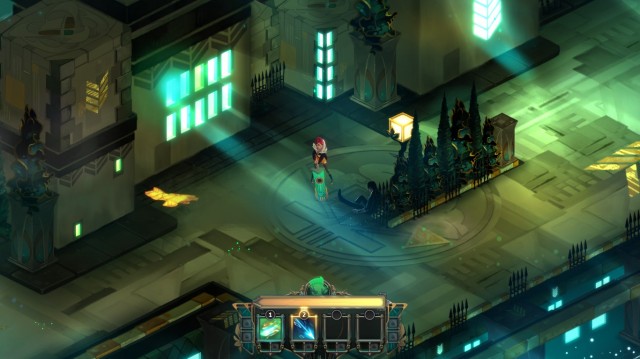
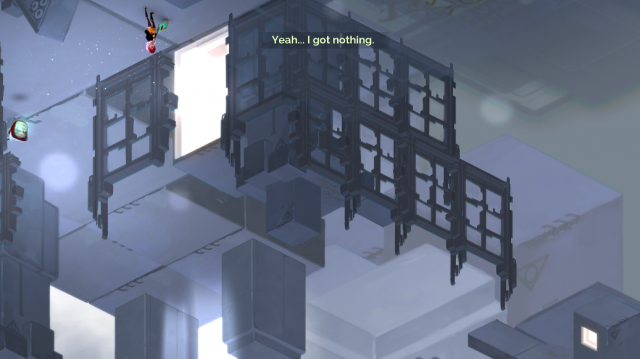
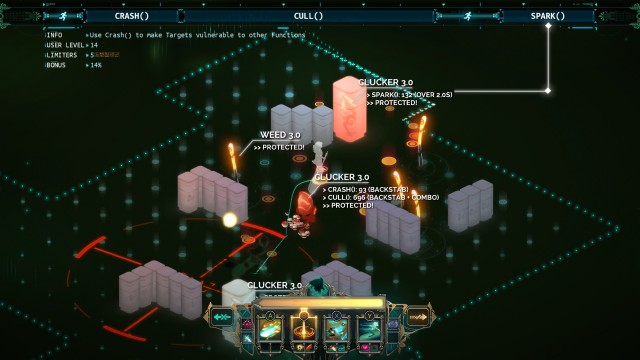



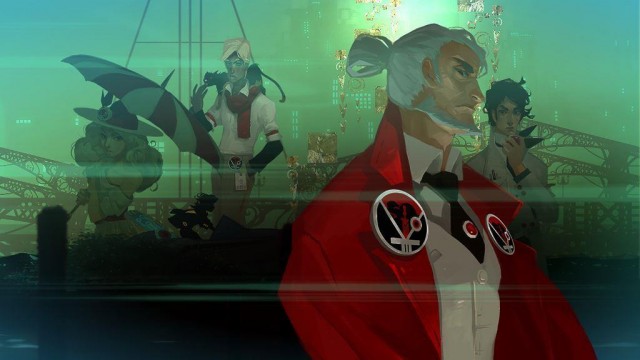
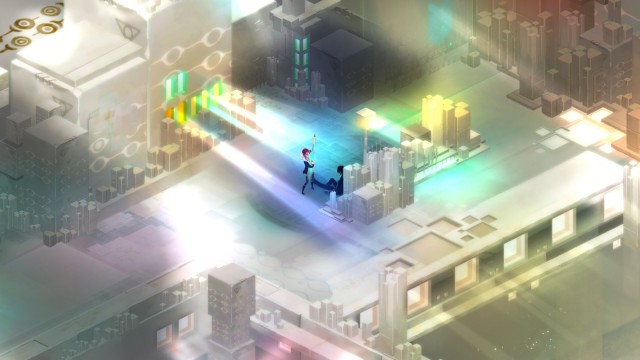
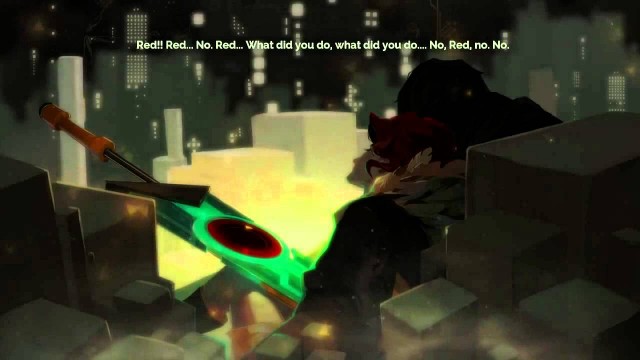
Well, that’s a fascinating review and hypothesis of the game, Luke. I kind of wish I had played it to completion, now. For some reason, I was hit with analysis paralysis when it sank in how I could mix and match the traces to affect combat. It sounds like this was a very cleverly thought out game.
@ Gothmog:
It kinda annoyed me that you temporarily “lose” a function instead of dying, making the next combat harder, but that specific mechanic was the primary reason why I even bothered experimenting with putting different functions in different slots. Near the end of the game I discovered a decent combo that allowed me to back-stab the Man units to death with relative ease and I mostly kept that intact for the last half an hour or so.
The final battle was the most difficult one because the boss has a transistor of his own, and he can freeze time just as you can.
My take on the game is pretty much this, with a few differences.
– I do think the final battlefield is “inside” the transistor, considering every pod maps to a transistor function.
– I also gathered that the characters in the game are artificial constructs, not plugged-in people at all–although at this point, the difference here is probably irrelevant.
– Some things I don’t have an explanation for, like why Red lost her voice, considering Breach() took the hit intended for her. It’s fitting that Red’s function is called Crash(). I wonder if Turn() is the trace of a person… or a primitive.
I just finished it, and I’m planning to dive right back into NG+ (or Recursion, as it calls it). I loved the deep combo system and the penalties. I often settle into a comfortable skill build in most action RPGs, a configuration that’s almost certainly a local maximum for fun or engagement. Transistor’s penalty system kicks you off your little peak and forces you to hunt for something better–And there’s always a better skill set waiting to be discovered!
That it remains ambiguous and open to interpretation is also fantastic. What I really want in such games is atmosphere, not story, and Transistor is drenched in it.
I’ve also been researching theories on the game quite a bit(I’m making a tabletop rpg campaign located in cloudbank). I am frustrated that there isn’t much focus but on the culture and atmosphere of cloudbank. When we play the game, the world is changing. We never see it as it was. There are tons of clues as to what it was like and oddly enough for a world in which everyone can vote for everything and everything sound like it is just and fair there are several mentions of violence building. Red’s files talk about how her music has made controversy and how one of her shows incited a riot. I think that there must be more to the reasons and workings of the Camerata that have to do with this. Also whats the whole deal with Fairview and the new bridge? Its a new thing that’s happening, but why is it new? Why haven’t they been connected before.
Personally, I don’t think “the country” is a place. I think it’s polite way of saying someone died whose terminology is based on a the citizens nostalgia and idealism for nature. I imagine that much like the sandbox areas, that the inside of the transistor is chosen by the wielder and Red chose it to look like that. This is why the fight sequence with Royce has giant Transistors in the background. Royce is pretty obsessed with it. Also it is noticeable that “the country” is romanticized. There only a few only a few birds and no other people visible besides Red and “The Boxer”.
I find one of the weirdest and most motivating parts of the game is the lack of living people. You run into a few dying people, you meet Royce at the end of the game, and after you die you see “The Boxer”. Sure, everyone is trying to escape the city but there are surprisingly few stragglers and honestly few bodies for a city with a monster on attack. Also I’m curious to know what other people think the little ghosting effect of what looks like people are? They sometimes appear on the streets before the Process takes over.
I think the Process is a sort of evolving organism or software. Its a product of continually rebuilding the city and doing its basic functions. It made tools to do help more efficiently do its different jobs and then those evolved to be more and more like the lifeforms of the city.
Also I think Grant and Royce were the only members to actually care about the Camerata’s goals. Grant’s boyfriend was just really obsessed with making Grant happy and Sybil is power hungry and out to really only help herself. Royce seems more to care out of curiosity more than will power and Grant could be seen to be having a confused life crisis of doing his thankless job for so long. ?
@ Karthik:
Red could have lost her voice as part of a proximity thing to the attack. Its odd that she can hum but not speak. Maybe her tongue was downloaded. Or maybe its psychosomatic from the shock of the event.